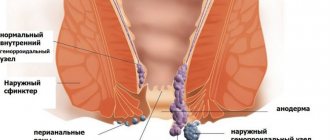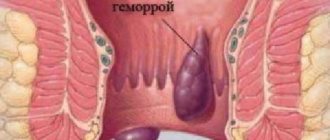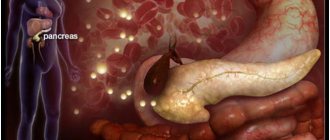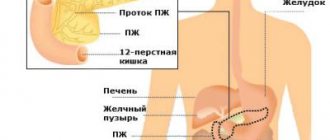What is the connection between the pancreas and diabetes?
The pancreas is an organ that produces insulin and plays an important role in regulating blood glucose levels.
There is a clear connection between the pancreas and diabetes. Type 1 diabetes occurs when the pancreas does not produce enough insulin. Type 2 diabetes develops when the body cannot use insulin properly.
In this article we will look at the connection between the pancreas and diabetes. We will also describe complications of diabetes related to the pancreas and other organ disorders.
Blood test for glucose: normal indicators
What is the normal blood glucose level?
| Patient type | Normal blood glucose levels |
| In adults | 4.1–6.1 mmol/l |
| In children under 14 years of age | 3.3–5.6 mmol/l |
| In women during pregnancy | 4.1–5.1 mmol/l |
This test is taken after an 8-14 hour fast. Blood is drawn from a vein.
What you need to know about the pancreas
The pancreas is located in the abdomen, behind the stomach, and it produces digestive enzymes.
It also produces insulin, a hormone that regulates blood sugar. The cells that produce insulin are called beta cells. They are located in the islets of Langerhans, located in the body of the pancreas.
Insulin helps the body use carbohydrates in food for energy. It transports glucose from the blood to the body's cells. Glucose provides cells with the energy they need to function.
If there is too little insulin in the body, cells can no longer absorb glucose from the blood. As a result, the level of glucose in the blood increases.
Development of diabetes with pancreatitis
Pathological anatomy of the pancreas is quite simple. However, this cannot be said about the functionality of the internal organ. The pancreas is located between the stomach, spleen, liver and duodenum.
Performs two main functions. It secretes pancreatic juice and also produces a unique hormone called insulin. It is this substance that helps bind glucose, as a result of which it is absorbed at the cellular level.
High sugar with pancreatitis, an imbalance in the chemical balance of pancreatic juice are the key symptoms of developing diabetes mellitus. Depending on the concentration of sugar in the blood, the severity of the pathological process is determined.
What exactly is the connection between the pancreas and diabetes?
Type 1 and 2 diabetes are related to the pancreas.
Diabetes is characterized by high blood sugar levels. This is a consequence of insufficient insulin production or function, which can be one of the consequences of problems with the pancreas.
People with diabetes have varying blood sugar levels depending on what they eat, how much they exercise, and whether they take insulin or diabetes medications.
Type 1 diabetes
Type 1 diabetes occurs when the pancreas does not produce enough or any insulin. Without insulin, cells cannot get enough energy from food.
This form of diabetes occurs as a result of the immune system attacking the insulin-producing beta cells of the pancreas. Beta cells become damaged, and over time the pancreas no longer produces enough insulin to meet the body's needs.
People with type 1 diabetes can balance their blood glucose levels by injecting themselves with insulin each day or by getting an insulin pump.
Doctors once called this type of diabetes "juvenile diabetes" because it most often develops during childhood or adolescence.
The main cause of type 1 diabetes has not yet been identified. Some evidence suggests that this diabetes is a consequence of genetic or environmental factors. In the United States, an estimated 1.25 million people live with type 1 diabetes.
Type 2 diabetes
This type of diabetes occurs when the body creates insulin resistance. Although the pancreas can still produce the hormone insulin, the body's cells can no longer use it effectively.
As a result, the pancreas produces more insulin to meet the body's needs, and is often no longer able to meet the increased demand.
When there is not enough insulin in the body, diabetes develops. Over time, beta cells become damaged and may stop producing insulin altogether.
Like type 1 diabetes, type 2 can cause blood sugar levels to rise and prevent cells from getting enough energy.
Type 2 diabetes can be the result of poor genetics and family history. Lifestyle factors such as obesity, lack of exercise and poor diet also play a role. Treatment often includes increasing your level of physical activity, changing your diet, and taking certain prescription medications.
A doctor can detect type 2 diabetes in an early stage called prediabetes. A person with prediabetes may be able to prevent or delay the onset of the underlying disease by making immediate changes to their diet and lifestyle.
Diabetes mellitus during pregnancy
Pregnancy can cause type 2 diabetes, known as gestational diabetes. This type of diabetes can cause complications during pregnancy and childbirth.
Gestational diabetes usually goes away after birth, but there is evidence that it increases the risk of developing type 2 diabetes later in life.
Pancreatitis + diabetes mellitus
When sugar is elevated during pancreatitis, it is dangerous for human health and life.
On the one hand, the inflammatory process that accompanies pancreatitis has a negative effect on the pancreas. On the other hand, diabetes leads to an acute lack of insulin in the body. Thus, a double aggressive effect is created on the pancreas, which leads to disruption of its functionality, and restoration of normal cell function is impossible. If there is no treatment, there is a high probability of disability and death.
High levels of sugar in the blood plasma in combination with inflammation of the pancreas leads to clinical manifestations:
- Frequent exacerbations of chronic pancreatitis, accompanied by severe pain.
- Stomach cramps.
- Dry mouth.
- Constant thirst.
- Increased specific gravity of urine.
- Belching with an unpleasant odor.
- Painful sensations in the sternum area.
The listed signs are accompanied by other symptoms. All patients complain of increased gas formation, bloating, abdominal colic, extending to the genital area and anus.
Weakness, dizziness, loss of consciousness are harbingers of hyperglycemic coma. The skin becomes pale, sticky sweat is released, bluish areas appear around the eyes - the development of cardiovascular failure.
Combined negative symptoms give rise to pancreatic type diabetes mellitus.
Diabetes and pancreatitis
Pancreatitis causes inflammation in the pancreas.
There are two types of pancreatitis:
- acute pancreatitis, in which symptoms appear suddenly and last several days
- chronic pancreatitis, a long-term condition in which symptoms come and go over several years
Chronic pancreatitis can damage pancreatic cells, which can eventually cause diabetes.
Pancreatitis is treatable, but severe cases may require hospitalization. Anyone should take pancreatitis seriously as it can be life-threatening.
Frequent symptoms of pancreatitis:
- vomit
- pain in the upper abdomen that may radiate toward the back
- pain that gets worse after eating
- fever
- nausea
- jumping pulse
Educational program: diagnosis of pancreatitis
Pancreatitis has been and remains one of the most formidable enemies in gastroenterology - 20% of patients die within 10 years after diagnosis. At the same time, the prevalence of the disease is up to 50 cases per 100 thousand population. These statistics are truly frightening.
Modern medicine has made great strides in terms of not only treatment, but also diagnosis of diseases; medical communities have developed algorithms and recommendations on how to find, catch and destroy the “enemy of health” as soon as possible.
Just ask
The first and most obvious method is a survey. What makes you pay attention to the pancreas? Everything here is quite simple: girdle pain, mainly on the left side, arising after eating disorders (a bitter price for heavy feasts). And also nausea, sometimes to the point of vomiting, bloating, abnormal stool - it is copious, shiny, with an unpleasant odor.
These symptoms may not be very pronounced, but, loud or quiet, they indicate that not everything is in order in the pancreas and it is not coping with successfully compensating for its “weak” points.
First tests
At your doctor's appointment, you will most likely be asked to take a biochemical blood test, a complete blood count and a general urine test, as well as determine the level of glucose and glycated hemoglobin. All this is necessary to assess the condition:
- a general blood test will tell you whether there is an inflammatory process and how severe it is (you need to look for an increase in the erythrocyte sedimentation rate, an increase in the number of leukocytes);
- biochemical analysis can also be informative: acute pancreatitis will cause an increase in amylase, although in chronic pancreatitis you may not see an increase in amylase in the blood, as well as an increase in the level of amylase in the urine;
- the level of glucose and glycated hemoglobin will indicate endocrine insufficiency, which often develops with a long course of pancreatitis.
Determining the activity of elastase-1 in feces is of great importance in the diagnosis of chronic pancreatitis. This enzyme is produced in the pancreas and is stored as it passes through the gastrointestinal tract, so its activity reflects the functionality of the pancreas. Low elastase levels are an indication for lifelong use of enzyme preparations.
It will be important to examine the feces themselves. Since food is processed by enzymes, their deficiency will lead to impaired digestion of nutrients, which will be manifested by various pathological components - fat, muscle fibers, starch. Accordingly, the volume of feces itself will increase, because both digestion and absorption are impaired.
Complex Methods
The most famous and popular method of examining the pancreas for pancreatitis is ultrasound. Ultrasound allows you to identify obvious organic changes such as cysts, calcifications, dilation of the main pancreatic duct and exclude surgical or gynecological pathology.
However, ultrasound may not notice early changes. Therefore, most often for the primary diagnosis of pancreatitis, a multislice computed tomogram (MSCT) is chosen. Layer-by-layer sections have greater diagnostic value and greater “resolution,” which will make it possible to better discern the structure of the pancreas for stones (stones), dilation of the ducts, as well as edema and necrosis.
According to ultrasound and CT data, a diagnosis can be made based on the Cambridge classification, which distinguishes three degrees of severity, as well as normal and questionable diagnosis. Thus, both of these methods complement each other quite well, but it is logical to go from a simpler method to a more complex one, based on the results.
An even more complex but accurate method is contrast-enhanced MRI of the pancreas (MRCP) with secretin stimulation. Secretin causes the pancreas to work more actively, and contrasting, i.e. filling the pancreas with a contrast agent, forms a diagnostic picture. If there are any minor problems, this will be “displayed” on it. Of course, this method is one of the most advanced, but in Russia, unfortunately, such diagnostics are not yet carried out and are not licensed. It should be noted that MRI itself (without secretin stimulation) does not have any particular diagnostic advantages over MSCT.
In some cases, endoscopic ultrasound examination - endosonography or EUS - is performed. The principle of the study is the same as with a conventional ultrasound, but the endoscopic approach allows you to see “more and better.” In this case, stones even smaller than 3 mm can be detected, which gives this method an advantage in diagnosing early forms of pancreatitis. The only negative is that it is still an endoscopic procedure, which causes discomfort. Few people like to “swallow a pipe.”
The wide variety of diagnostic methods should not cause a feeling of chaos - everything is structured very logically. At the first stage, it is proposed to take tests and conduct an ultrasound. If the results are questionable, it is rational to undergo more complex procedures, such as MSCT or EUS. An MRI of the pancreas is also possible. It is mandatory to examine stool and determine the activity of elastase-1 in stool, which for any diagnosis will help determine the direction of treatment and increase the accuracy of diagnosis.
Natalia Skogoreva
Photo depositphotos.com
Diabetes and pancreatic cancer
According to the Pancreatic Cancer Society, people who live with diabetes for 5 years or more are 1.5 to 2 times more likely to develop pancreatic cancer.
The onset of type 2 diabetes later in life may be a symptom of this type of cancer.
The direct link between diabetes and pancreatic cancer is still poorly established. Diabetes is known to increase the risk of developing this type of cancer, and pancreatic cancer can sometimes lead to diabetes.
Other risk factors for pancreatic cancer:
- obesity
- aging
- poor nutrition
- smoking
- genetic inheritance
In the early stages, this type of cancer may not cause any symptoms. Doctors most often diagnose it in the later stages, when the patient is usually no longer operable. Therefore, it is necessary to undergo an annual examination of the gastrointestinal tract.
Other diseases of the pancreas
Cystic fibrosis can also lead to the development of insulin-dependent diabetes (type 1).
In a person with cystic fibrosis, persistent sticky mucus causes scar tissue to form on the pancreas, and scarring can prevent the organ from producing enough insulin. As a result, cystic fibrosis-related diabetes (CFRD) may develop.
The signs and symptoms of CFRD may resemble those of cystic fibrosis. A person may not know that he does not have cystic fibrosis, but diabetes, until he passes the appropriate tests.










